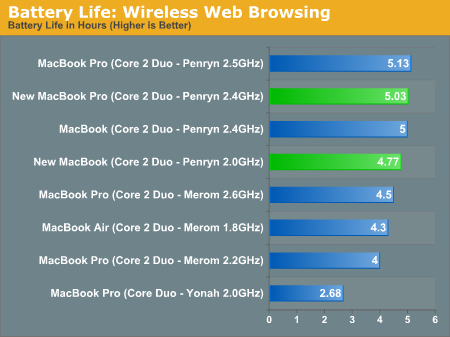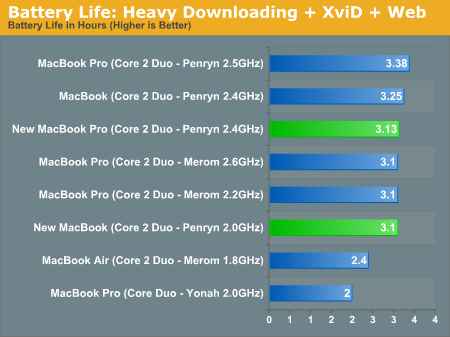Apple's Redesigned MacBook and MacBook Pro: Thoroughly Reviewed
by Anand Lal Shimpi on October 22, 2008 12:00 AM EST- Posted in
- Mac
Battery Life: Take Two Steps Forward, and Two Steps Back
If we look at the power consumption comparison we did in our GeForce 9300 review you'll see that the NVIDIA chipset pulls around 10W less power than G35 at idle, extending up to 15W under gaming loads. NVIDIA's 65nm GeForce 9400M used in the new MacBook and MacBook Pro is effectively the same chipset and thus it's safe to assume that there's a healthy reduction in platform power consumption afforded by the new hardware.
Apple reduced the capacity of both the MacBook and MacBook Pro batteries by 10W (60WHr down to 50WHr for the Pro and 55WHr down to 45WHr for the standard MB). Given that total platform power consumption should go down by around 10W, Apple's efforts here seem to make perfect sense. Smaller batteries mean lighter and potentially thinner notebooks; unfortunately it also means that battery life won't improve at all.
To test this theory I ran two of the battery tests I did back when the first Penryn MacBooks launched:

The web browsing test shows that the MacBook Pro battery life remains basically unchanged, while the MacBook takes a slight hit compared to its predecessor. For all intents and purposes, these notebooks won't last any longer than the old ones.
The same thing is true about the heavy usage scenario: battery life basically remains unchanged:

Note that in both of these tests the MacBook Pro's GeForce 9600M GPU was disabled and only the chipset's internal GeForce 9400M was used. Apple indicates that you lose 20% of your battery life if you use the 9600M on the MacBook Pro; to test this I ran the heavy usage scenario benchmark but with the 9600M enabled:
| GeForce 9600M Disabled | GeForce 9600M Enabled | |
| Battery Life (Heavy Usage Test) | 3.13 hours | 2.37 hours |
Using the dGPU dropped battery life by 24%, which is close enough to Apple's numbers to call them relatively honest. I also appreciate that Apple's 5 hour battery life is about what I got with the MacBook Pro in my web browsing test. Honesty is very important in any relationship, even if it's one between a manufacturer and a consumer.










66 Comments
View All Comments
plonk420 - Thursday, October 23, 2008 - link
could anyone test this with the new (and even old) Mac Book Pro to test for CPU usage?http://www.megaupload.com/?d=ADFYX083">http://www.megaupload.com/?d=ADFYX083
h.264 high profile (QT supports this now, right?) level 4.1 720p60, fairlight/the black lotus's demo Only One Wish (2nd place at Intel's second demo compo) .. has some really handsome bitrate spikes :D ~mid 20s mbps spikes (but not as good as the 60mbit spikes in a 6 or 8mbit (average) encode of ASD's Antisize Matters)
michaelheath - Thursday, October 23, 2008 - link
Having spoken to a few Apple developers I know, the reason for this oddity is Nvidia's software implementation for Mac OS 10.5. While the ideal situation was for them to be able to switch on the fly, the agreement between Apple and Nvidia to develop for the new MacBooks and MacBook Pros happened so quickly it left little time to create a proper application that would allow for this (think of how you had to restart your computer to turn SLI on or off: same slapdash type of programming).The hope is that quick-toggling between integrated and dedicated graphics will come with Mac OS 10.6 as it may be too large of an update to patch Mac OS 10.5. It also makes sense in this aspect as Mac OS 10.6 also includes OpenCL GPGPU algorithms, which Nvidia is already promoting and developing under their CUDA platform.
RDO CA - Thursday, October 23, 2008 - link
On my Thinkpad T-400 with switchable graphics all that is needed to switch is to go to the taskbar icon and click switchable graphics and choose what you want and the screen goes dark for a second and thats it.cliffa3 - Thursday, October 23, 2008 - link
I'll test it sometime this week, but on my Lenovo T61 it seems like I get much more life out of Ubuntu than I do Vista 64-bit. Could be a windows thing in general, not just something that OS X does better.How was the battery life comparison between XP and Vista?
PilgrimShadow - Thursday, October 23, 2008 - link
Anyone know if the 9400M and 9600M appear in Vista's Device Manager?TallCoolOne - Thursday, October 23, 2008 - link
I bought the new 2.0GHz MacBook last week as my first Mac and can say I'm not disappointed. The whole chassis feels as solid as, well, a block of aluminum! As Anand said, it feels like you get what you paid for. I actually like the multi-touch gestures, such as swiping with 3 fingers to flip pages and for back/forward when web browsing. I'd like to see iTunes also support that gesture. Two finger scolling is another great feature not mentioned in this article. What I don't like though is the stiffness of the mouse click. It takes far more pressure than any mouse and that required pressure is uneven in different areas of the trackpad. Pressing near the top requires more pressure than near the bottom. As for lack of standard SSD, Anand, perhaps you're a little too spoiled by that speed! I would not expect that as standard on even the fastest MacBook Pro at current prices. That is, unless you'd like to see the asking price for a MBP $500-600 more than it is now.vlado08 - Thursday, October 23, 2008 - link
It is interesting was vista side panel running during the test. Also was this fresh install of vista os. If it was fresh then was the indeing enabled.vlado08 - Thursday, October 23, 2008 - link
edit indeing - indexingjmpt2 - Thursday, October 23, 2008 - link
Very interesting to read your conclusions about better power management in MacOS vs Vista. This matches my experiences running Vista on the BootCamp partition of my Core Duo MacBook, and is the first time I've seen this discussed anywhere on the web. I found that with a main battery in quite poor condition after two years constant use, it became impossible to use Vista on battery power for more than a minute without the battery deciding it was empty and putting the machine into sleep mode. Under MacOSX the system could still be used for 30min+ (light use) before the same thing happened.I'd come to the conclusion that Apple were deliberately playing games with the ACPI tables to confuse Vista's power management code and make their own OS look better. This seemed to be supported by the fact that Vista is unable to correctly detect the charging state on my MacBook - running on battery power it would always report "Connected to mains, not charging". Does it still work that way on the latest MacBooks? In any case, your data does seems to suggest the problem is a more general issue with Vista. Sounds like you should investigate further...
BZDTemp - Thursday, October 23, 2008 - link
I wonder if OS X lasting longer on a battery can be transfered to the world of none portable?In other words say I run OS X on my daily, none laptop, work machine doing surfing, writing and perhaps listening to music(FLAC prefered over MP3) or even watching an episode of The Daily Show. Will this draw less power from the wall with a PC running OS X than with the same machine running Windows (and is there a difference between Windows versions). Also Linux should be included in the test.
Imagine the perspective - with the whole green computing movement this could really make a difference not just in the server rooms.
Please do check this out - this is not only interesting for us geeks but could make Anandtech something referred to by none-tech news media.